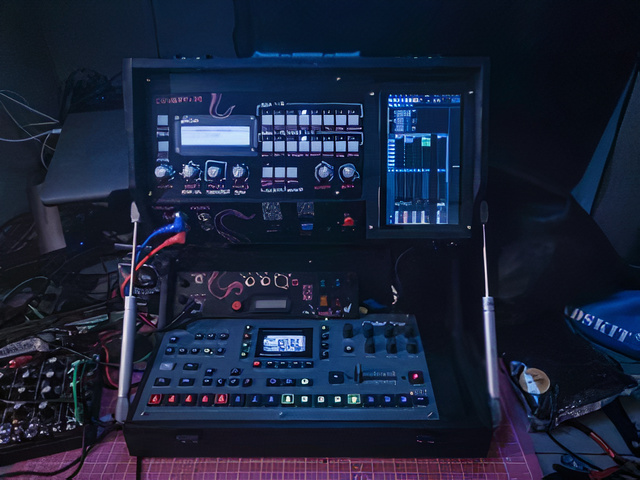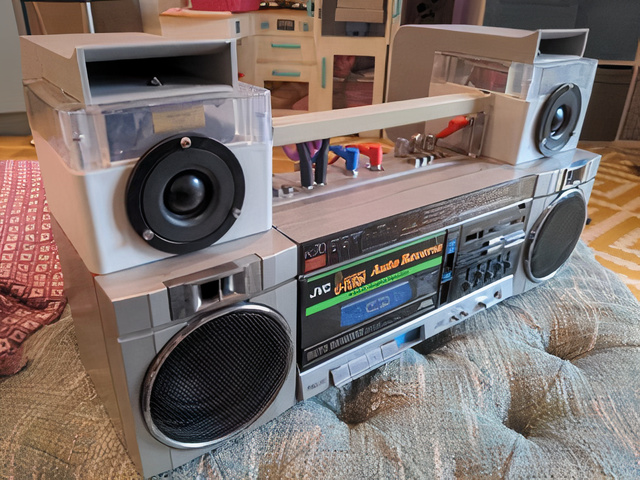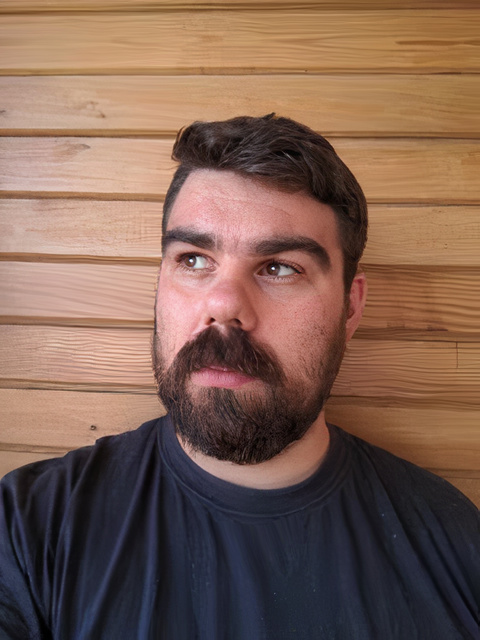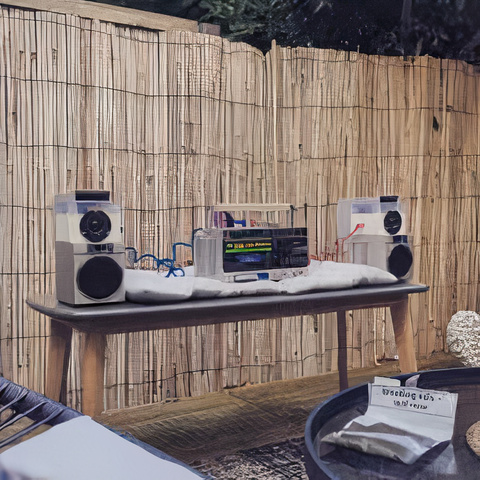DIY projects are one of the best ways to show that art can be environmentally friendly yet innovative and fresh. As consumerism becomes one of the biggest flaws of our society, it is important to find a way to change our habits and act more conscious towards our surroundings. As artists, we must keep constantly creating and, at the same time, spread positive messages to the people who believe in our works. Music producer, designer, programmer, and maker from England, United Kingdom, Emil Smith has created many DIY projects throughout his career, and he is not planning on stopping anytime soon. Thus, we invite you to learn more about his work ethics, projects, and creative journey.
Let’s talk about your first creative steps. When and why did you decide that art will be your life’s path?
I wouldn’t say this was much of a decision per se. I have always found art (in one form or another) to be my way of interfacing with the world around me. That includes drawing, writing, music, or even engineering. I started drawing obsessively as a kid, progressing to larger format paintings on canvas, then to even larger paintings on walls and train tracks around London. Meanwhile, I graduated from drumming on pots and pans in the kitchen to drumming in bands, to writing drum & bass music, which led to me having several label releases and playing my first international gig. I wouldn’t say I ever had to make a decision; art was just always there, and I wouldn’t be who I am without it.
You have created so many DIY projects. Why do you prefer making things from scratch instead of buying the final product?
Understanding how things work is so much more interesting and valuable than just understanding how to use them, and I think this applies to anything. As a musician, understanding the actual physics of sound and the underpinnings of pitch, amplitude, timbre, and so on enables you, as a musician, access to a much wider palette of expression. Similarly, understanding the inner workings of technological products, for example, allows you to extract more from them or augment their functionality to suit your needs better. I also feel passionate that our society is built on a culture of consumption and implicit waste. Buying a brand new product usually means an old one gets thrown away, and there’s a common disrespect for things that are no longer considered to be on the bleeding edge. People commit their smartphones to landfill every two years in favour of a new model with even more memory, CPU cores, or imperceptible pixel density, when 10 years ago that smartphone would have been incomprehensibly powerful. I think it’s imperative that we as a society learn to break that cycle, repair, and maintain products rather than allowing ourselves to be blinded by material trends.
My boombox is really an example of this philosophy. I found it on the street as a teenager in 2006 in working condition. Over the years, it just kind of stayed with me. Once some of the components started dying, it became a brilliant analogue stereo distortion unit for a while – I had it set up as a hardware effect in my DAW so I could run sounds through it. I created a sample pack of some of the results. Once it finally died, I always planned on bringing it back to life, and now it’s finally done. It’s the same old chassis, but now it’s filled with modern components; new drivers, crossovers, an amp, Bluetooth functionality, and of course, an incredibly powerful DSP processing unit in the form of a Raspberry Pi running Patchbox OS. It’s amazing to think that this old boombox from 1986 is becoming more powerful with age.
Let’s talk a bit more about your portable music production studio. How did you come up with this idea? As a music producer, why did you feel the need for your studio to be portable?
When I started working on my music box, I had become somewhat disenfranchised with the music industry from my perspective as a producer. I had been working on putting out music in a specific genre quite consistently, and it was feeling a lot like work. I found I wasn’t enjoying the creation process so much and was spending an inordinate amount of time maintaining relationships with people in the industry, managing social media accounts, and negotiating with label managers and promoters, which was all just incredibly boring. I used to take a laptop on my commute to my day job as a digital designer/developer to produce music on the train. Working full-time doesn’t leave much room for music production, and it seemed like my two hours of commuting every day could be better used as creative time. As I started breaking out of my typical workflow and looking for something new, I fell in love with hardware, and I wanted a way to bring that with me.
The box I have now, which I called “COVERT-19” (I finished it during the first lockdown, and it has a Virus in it!), was really just the latest stage in a progression from my laptop. I bought an Elektron Digitakt, which I could run off a small USB battery pack, and after using that for a few months, I realised I really wanted to add a synth into the mix and find a way to arrange full songs. I sold the Digitakt and bought an Elektron Octatrack and a Virus TI Snow, which I built into a makeshift wooden box with the same battery pack. After a while, I found I was missing my old mixing capabilities from my DAW, like sidechain compression, mix buses, and master effects. So I started planning out a way to add that capability to my portable setup, and before I knew it, I was cutting up audio interfaces, building a custom battery pack from scratch, and taking all the PCBs out of my Virus.
Ironically, by the time lockdown was over, I was working fully remotely and have been ever since. So the latest iteration of the box hasn’t seen much road-time yet, but it’s still great to be able to bring it out with me occasionally, or even just to be able to sit outside with it and jam away from a desk.

We have noticed that you use Patchbox OS software for your DIY boombox. What role does it play in your project, and why did you choose it over any other software?
When planning the boombox project, I used some speaker simulation software called WinISD to design the enclosures for the speakers. The original boombox only had one full-range, 8W driver per channel, and I wanted to move to a two-way design and add a ton of low-end capability without needing a dedicated subwoofer. As the plan developed, I realised that not only would I need to increase the enclosure volume and add ports to the enclosures, but to manage the air pressure inside the enclosures and prevent the drivers from being damaged by high excursions caused by subsonic frequencies, I would also need to add a subsonic filter to the signal. This would strip out unwanted low-end information, increasing SPL, reducing driver excursion, and improving overall efficiency. The problem I found was that there wasn’t a decent off-the-shelf solution to this problem, and it would involve either designing and soldering an analogue filter or incorporating a digital alternative. Aside from the subsonic filter, I also wanted a way to EQ the signal, as the tweeter drivers I used are much more efficient than the mid-bass drivers, meaning the high end would be too loud relative to the low-mids.
I had a Raspberry Pi with a HifiBerry DAC+ADC Pro hat, which I had been using to play around with Elk Audio’s OS for another project, and I figured I could probably use that to do some DSP on the input signal. Unfortunately, after exhausting a number of possibilities, it seemed the only way I would get what I wanted with ElkOS would be to write the DSP code myself or spend a long time compiling plugins to work with the software and converting values between Hz and floating points. After a quick search online, I discovered Patchbox OS, and within a matter of minutes, I had it running on the Pi, and using MODEP, I had a Butterworth highpass filter, EQ, and a limiter up and running, with a well-designed web UI to tweak all the values. It all just fell into place so quickly and easily – it’s a really great piece of software!
Unfortunately, I had some issues with running both the power amp and the Raspberry Pi off the same power supply, causing lots of interference. I tried adding grounded copper shielding around the Pi, using shielded cables, adding ferrite cores, and so on. Eventually, I thought I’d try using a direct power source to the GPIO pins on the Pi, rather than USB-C Power Delivery, to ensure there was no data being exchanged via the power cable. What I didn’t realise was that the USB-A ports on my battery pack were not to standard USB spec and actually delivered 12 volts to the Pi, which killed it instantly, so for now, it’s running without Patchbox OS, though I do plan to get it back up and running very soon, with a dedicated battery to eliminate interference! I’m making do with lower volumes and the amp’s built-in, two-band EQ for now.
You have worked with big brands like Google, Sony, eBay, Virgin, Nokia, Tinder, and many more. Could you please share your thoughts on how working with big companies is different from working on your own projects?
In my professional life as a product designer and developer, I started out working in digital agencies on web and marketing projects for a range of businesses, from small, independent restaurants to huge, multinational corporations like the ones you mentioned. I’d say the main thing I learned from working on projects for large tech companies is that the talent of the people working for them, and the quality of their work, is really not that different from a lot of people I’ve known working in small development teams, for example. The real lesson was that some of the most interesting and smart people working on the coolest projects are often not working at large companies like that. It’s nice to have seen both sides of the game and experienced working with a range of different products, and that’s allowed me to make a confident decision that I get the most satisfaction out of working in small teams, or on my own projects, and that you don’t actually need a gigantic corporation behind you to innovate. I would even say that in my experience, the most innovative ideas are realised in smaller outfits without the burden of scale.
Being such a versatile artist, how do you manage to balance all your passions?
Balance? Who said anything about balance!? I work in a rather chaotic way, honestly. When I’m really into a project, it becomes my singular focus, and everything else gets pushed to the sidelines until it’s done. For years, that was music production, and I would really graft, putting the hours in around my full-time job and being a parent to make it fit. After I had some success in that area, I think I had proved to myself that I could do it, the pressure started feeling less worth it, and other stuff came in to fill the void. Essentially I tend to hyper-focus on one thing for anywhere between weeks and years, and as soon as I’m done with it, I move straight on to something else. Whatever it is I’m working on, I have to be very creative to make time for it and balance it with other projects, hence crazy ideas like bringing a hardware synth/sampler set up on the train every day! I also keep a lot of lists… Like, a lot of lists.

Could you please tell us more about your current projects that are still in development? What projects can we expect from you in the future?
I still have tons of unreleased music, and I know that at some point, it’ll return to the forefront, but for now, I’m really focused on making physical things; I’m doing a lot of 3D printing, learning about microcontrollers, electronics, DSP programming, and MIDI protocol stuff. It all feels very new and uncharted for me, which makes it challenging and compelling, so I’m excited to see where it all leads. I’m in the midst of printing parts for my new printer: A RatRig V-Core 3, which is a really insane, open-source, CoreXY printer. Once that’s done, my next project will be to start building an entirely self-designed and self-built digital eurorack set up (stating with a MIDI sequencer I’ve been writing in GoLang). Eventually, I’d love to be able to design and build musical instruments that other people can use.
Follow Emil Smith
InstagramPersonal Blog
Bandcamp
YouTube


